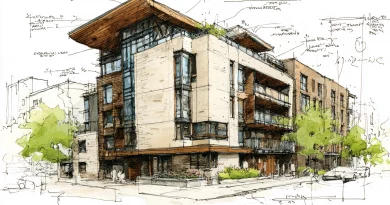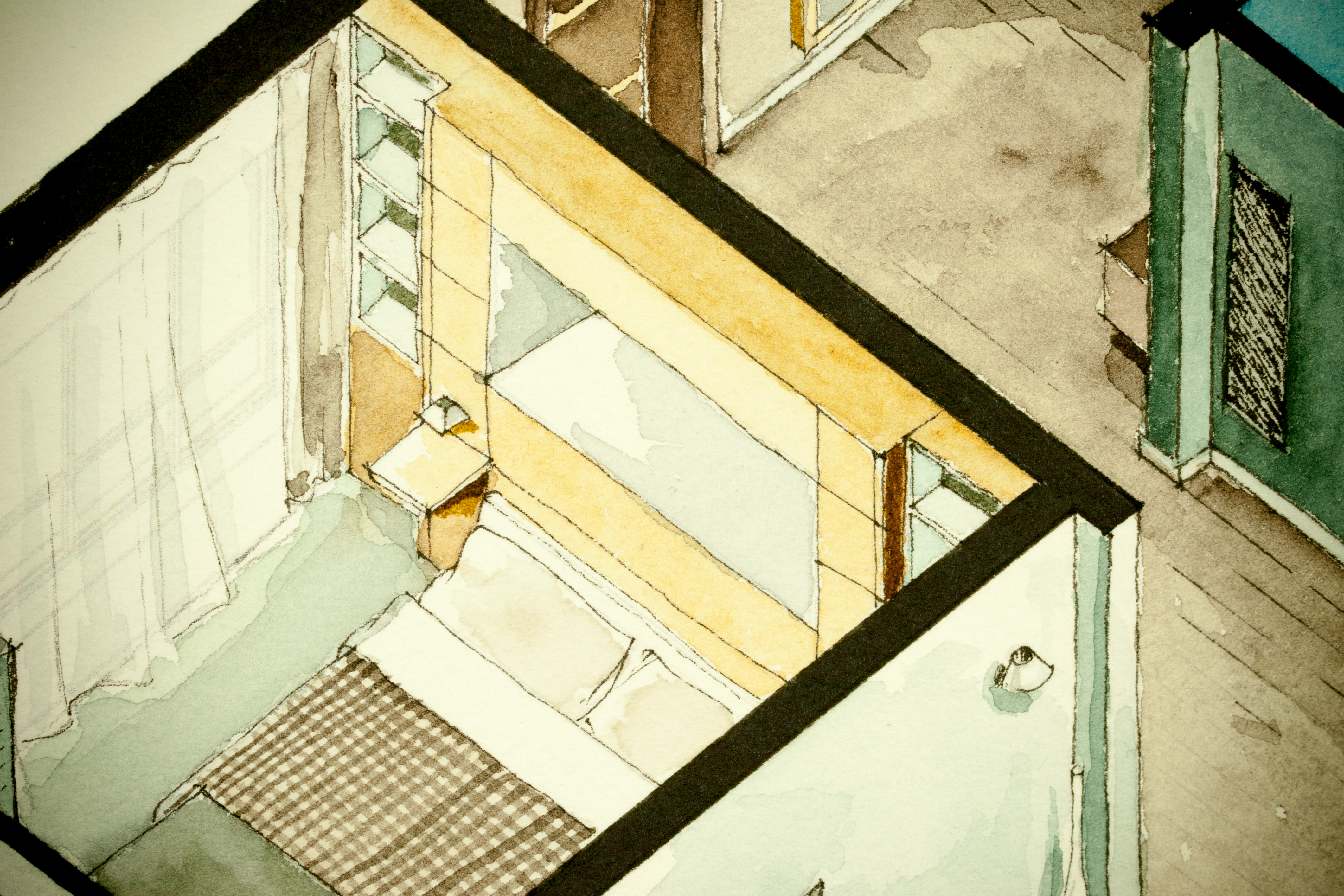Highlighting Detroit’s Sustainable Community Development Projects
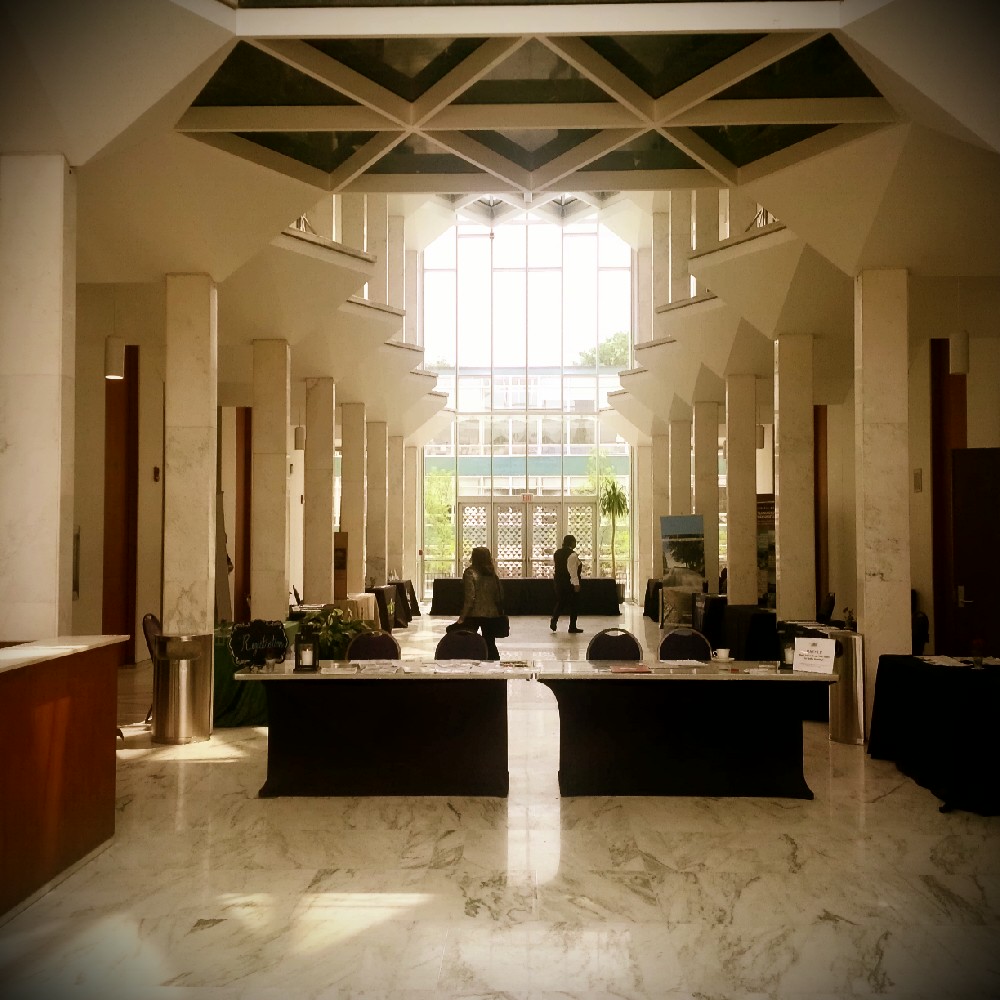
“We often hear about how it’s great to get like-minded people together in the same place,” one USGBC-DRC member said in a lunch conversation, “when, in reality, preaching to the choir is about the last thing we need for sustainability. We need to start reaching out to people who aren’t on board.”
This statement resounded in the theme of Monday and Tuesday’s conference, the DCAC Business and Institution Sustainability Summit produced by the Detroit Climate Action Collaborative (DCAC), a sub-acronym of Detroiters Working for Environmental Justice (DWEJ), a Midtown Detroit-based organization working in the intersection of sustainability, community development, and social justice. The conference brought together the likes of business and sustainability professionals, policy experts, students, and entrepreneurs.
Breakout sessions tasked diverse groups of attendees to tackle specific tasks: 1) Reducing Greenhouse Gas Emissions; 2) Creating Resilient Businesses; 3) Developing Public Policy; 4) Preserving and Conserving Water and Water Quality; and 5) Growing a Green Culture in Detroit. Tough questions were asked in sessions that brought community champions of environmental justice into the same rooms as corporate executives. In one introduction during a panel session, the moderator maintained congeniality and wit while taking no hostages:
“I run a company that recycles electronics,” the audience member said, identifying himself.
“Okay,” the moderator said, nodding with a grin. “So, you’re that guy who sends all of this toxic e-Waste to be sorted by poor people in Ghana or who-knows-where to turn a profit off some scrap gold?”
Over the course of sessions, each moderated quite differently, we honed some specific strategies to be presented later in the day, and each moderator brought a different perspective. George Davis, Manager of Public Safety and Public Affairs for the Detroit Salt Company, which still to this day mines salt from the deposits beneath the river (check out some more great history here), pointed out that Michigan’s industrial ingenuity originated in large part from the historical exploration of its natural resources, like iron in the Upper Peninsula, and this historical legacy can help inform entrepreneurial innovation in environmentalism and sustainability.
Lunch was punctuated by a keynote speech by John Viera, Global Director of Sustainability for Ford Motor Company, introduced by Dominic DiCicco, also of Ford, who covered Ford’s sustainability program. After an afternoon session of planning and a chance to visit some of the exhibitors including USGBC and various energy services companies like Walker-Miller Energy Services.
Environmental Justice & Sustainable Development Tour
The second day included a four-hour tour of Detroit, covering sites significant to environmental justice and sustainable redevelopment. We began at Socra Tea in the basement of 71 Garfield, where we enjoyed fresh scones and a tour by Diane Van Buren of Zachary and Associates, which developed the project. The building, which was renovated from a partially burned out shell in 2010, now hosts an advanced geothermal glycol loop system to provide heating and cooling and offsets its energy usage with a– drum roll- Solyndra photovoltaic system on the roof. Van Buren remembered the Woodward Avenue corridor of the 1990’s, where, while attempting to secure financing for a similar redevelopment project, bankers would all but laugh her out of the room. “They said, ‘No one will live on Woodward!'” she recalled. The corridor, where rents are now topping a dollar a foot, now offers hundreds of new construction and renovated housing units and is getting a streetcar line. Times change. The banking sector changes, too– very slowly.)
We then drove over by the Detroit Incinerator, a 68MW municipal waste-to-energy plant that provides electricity and district heat to the downtown. The plant was built in the 1980’s by a city in freefall that hoped it would be an economic development miracle, but most blame for poor air quality and the economic challenge of municipal recycling (why recycle when dumping fees are so low?). Ahmina Maxey, of Zero Waste Detroit, met us for a brief chat on the bus about the incinerator. Zero Waste Detroit is a coalition of local organizations interested in advancing recycling and better solid waste disposal options in a city that literally burns trash for heat.
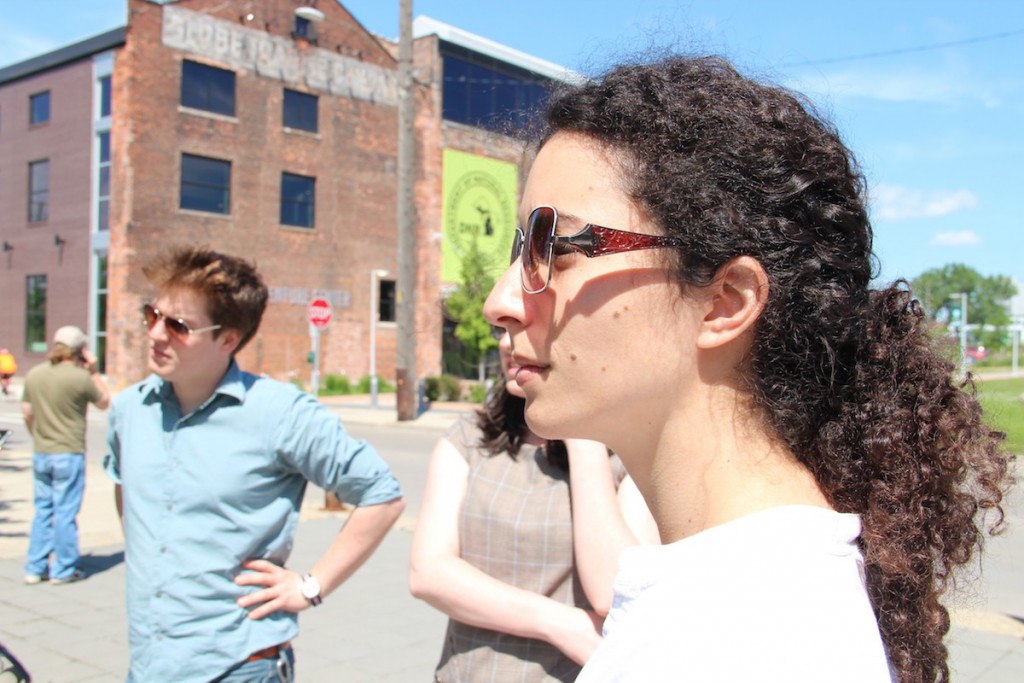
We then went for a walk down to the Riverfront, where we met with Prasad Gullapalli and Karin Viola from Srinergy, a Novi-based solar installer that developed a portion of the roof of the “new economy”-focused Elevator Building, offsetting about a third of the building’s electric load. We also strolled down along the river, past every type of Detroiter jogging, fishing, walking, and selfie-taking, passing by the Michigan Department of Natural Resources’ new Outdoor Adventure Center, which is slated to open some time this summer, and enjoyed ice cream under the concession stand’s ultramodern awning.
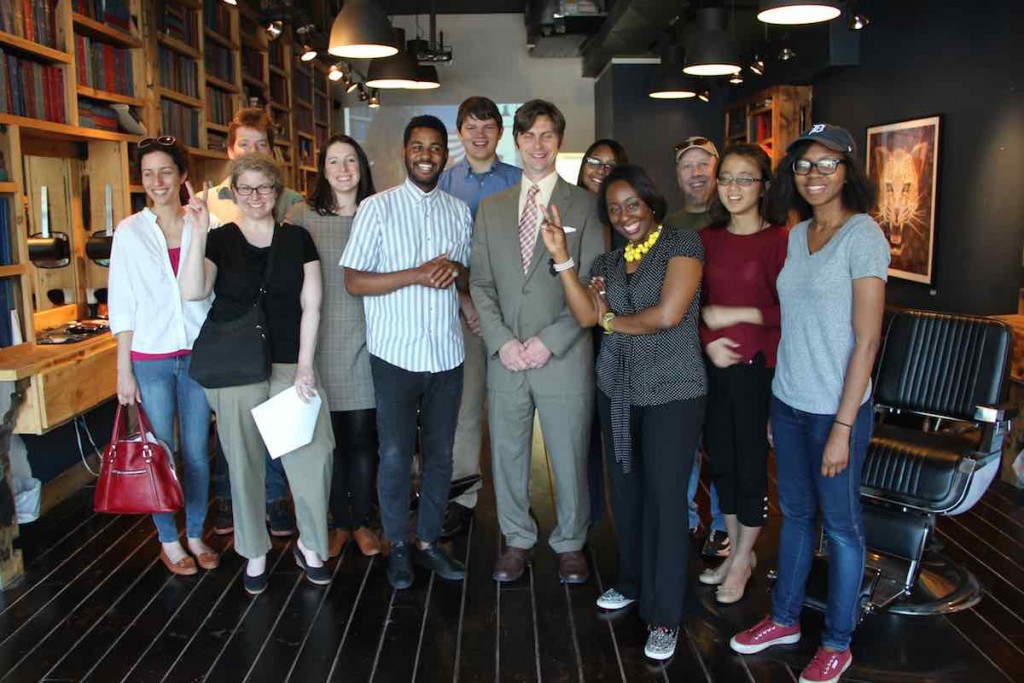
Post Riverfront, we stopped by Social Club (not to be confused with the British rock band), Sebastian & Gabrielle Jackson’s concept barbershop on Wayne State’s campus (picture below). The space, resplendent in wood salvaged from locally deconstructed houses, is not only a business but also a community gathering space (their Facebook page notably features more pictures of events and activities than it does pictures of haircuts). Jackson collects color-untreated hair, which has a high nitrogen content, to be used as compost in local community gardens.
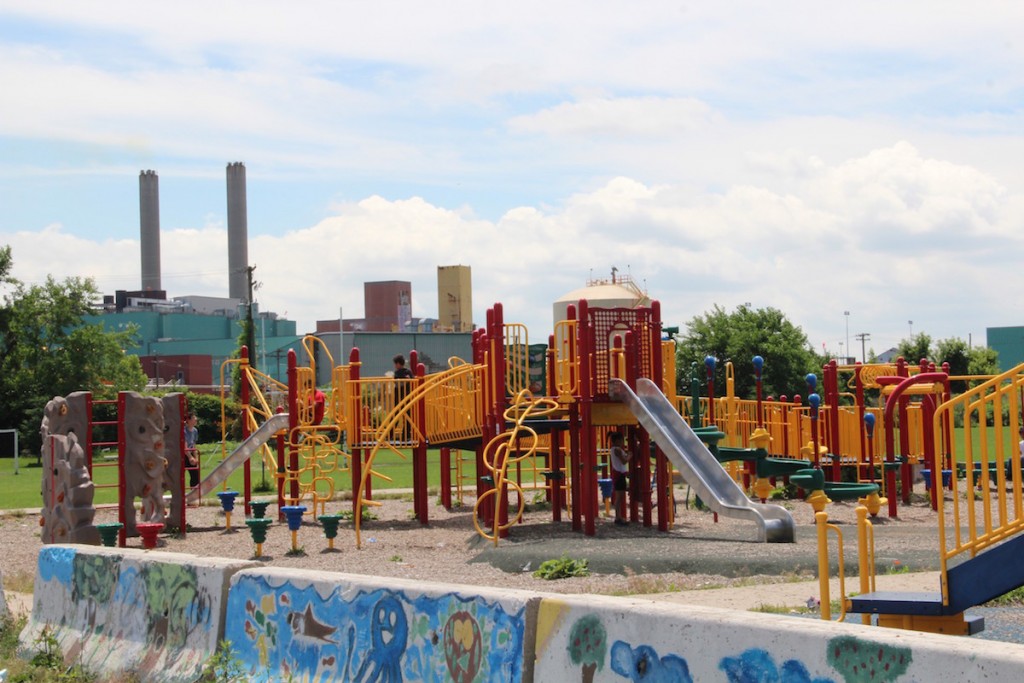
The last stop on our Tuesday tour was at People’s Community Services in Delray, where PCS Executive Director Greg Everett and the Southwest Detroit Community Benefits Coalition Program Director Simone Sagavac introduced us to the neighborhood, a few square miles sandwiched between all manner of industrial establishments including US Steel’s Great Lakes Works plant on Zug Island, a manmade body of land that has been likened on more than one occasion to an industrial Mordor, and the Marathon Refinery. Settled around Fort Wayne in the earlier part of the 19th century, the neighborhood became a thriving nexus of raw materials processing following its development as a major railroad hub, but began to suffer in the earlier part of the 20th century from the construction of a wastewater treatment plant, a coal plant (pictured above and still in operation), and as aging, dirty industry expanded while the city’s industrial base shrank as a whole. The 2008 recession struck the neighborhood hard, as it did the rest of Detroit, and the neighborhood is struggling to recover from nearly a century of disinvestment alongside the ongoing and looming environmental problems.
When asked about any positive impacts of industry on the neighborhood, Sagavac said that while they do not have good data on the percentage of factory workers who live locally, that the gradual upskilling of the workforce means that higher-skilled jobs are necessarily higher-paying, making it easier for these workers not to live in the community, thereby contributing to a shrinking population and a shrinking tax base. The Gordie Howe Bridge (2016-2019) that will connect Detroit to the Land of the Rising Oak Leaf is expected to radically transform hundreds of acres of the neighborhood through transportation interchanges and a large customs plaza, and Sagavac is hoping for a community benefits agreement that ensures that the neighborhood can benefit from jobs and economic development created by the project.
Interested in learning more about goings-on in the Motor City’s sustainability scene? Check out DWEJ and stay tuned to hear about some upcoming work we’ll be doing together later this summer.

